February 01-08 Salinas (A). Lat 17 57.154N; Lo 066 17.538W
**Still working on the starboard engine and Graham decided that the problem must be the fuel pumps; so we ordered two of them to be picked up in San Juan. Redundancy is our motto. Since the parts won't be in for a while, we relaxed and got on with other chores (refuelled, washed water maker filters, backed up computer, did our chart work for Cuba and Western Caribbean) and gadded about with some of the other great cruisers. Went to a party for 90-year old Verne on S/V Magus. We're old hands now and can tell the newer ones what to expect.
**The manatees must be in mating season. At one point, five of them were frolicking around the hull and actually brushing against it at times. We've been warned that they like inflatable dinghies and get quite amorous with them, making a bit of a mess. Lovely animals to watch.
**Rented a car for a third time. Shopped out. We picked up the fuel pumps ($200+).We also bought fabric, thread, strong needles, snaps, grommets, and other fittings (at a great price) to make awnings and shades on our own and probably saved at least $1000. Other cruisers gave us courage and lots of hints for sewing it all ourselves with our domestic machine.
**Tackled the engine again the day after we returned with the pumps. Very frustrating day. Graham struggled so hard to fit a new pump in a very awkward position and then we found that it did not work. !@#$%^& At 1630, he figured that it was indeed the !@#$%^& Racor filter. The housing had cracked. By 2130, he had done a jury fix up (with glue) and it worked fine. Graham is the man. We have both learned so much about being resourceful and inventive for repairs. (But just in case, we have ordered another Racor filter that Samantha will bring from Canada to Cuba in March!)
February 09 Gilligan's Island (A). Lat 17 56.815N; Lo 066 52.289W
We were SO glad to be moving again (very easy 6-hr trip, but all motoring due to lack of wind) on a beautiful morning. At 0730, we caught a 32" barracuda (big soppy eyes and nasty huge teeth) and a 15" barjack. Threw both back, but sadly, not quickly enough for the barracuda as we were flapping around trying to identify it. We also caught and kept a mackerel from which we hacked out 2 steaks. Wendy does all the fish dressing (but discovered I don't like to do this too early in the trip as the smell and blood all over the place makes me a bit nauseous.) Anyway, that was exciting fishing for us. The mackerel did not taste so good this time and we were glad we did not waste any bubbly with it. The anchorage was flat calm and quiet and we chatted with Cliff and Melanie (S/V Cliff's Note). We caught up with them several times and enjoyed their company.
February 10-12 Boqueron (A). Lat 18 01.223N; Lo 067 10.580W
We motored all the way (5 hrs) to Boqueron as there was too little wind again. Nice to be going with the wind behind you but you need a good 15+ knots to get anything out of the sails. Also going downwind means we generally use the genny as the main flaps too much. Enjoyed our guagua rides to Mayaguez (3 transfers and only $10 for a 30 mile trip each way and a stop for a final bash at WalMart) and cleared out with US Customs. Spent the day getting ready for the big passage, leaving 0800 tomorrow.
February 13-14-15 Passage to Dominican Republic
Well, for the first time, we began to enjoy a long passage (265 miles at an average of 5.2 knots). The first day was not pleasant but the wind calmed down (and that means smaller waves) and it became quite pleasant. Both able to read and relax and function normally. All food prepared beforehand.
Feburary 15-26 Luperon (A). Lat 19 53.778N; Lo 070 57.278W
Luperon was as wonderful as ever and it was so easy to get things done this time as we 'knew the ropes'. We had our teeth cleaned again ($15 each) and a crown repaired ($14), bought some more anti-hypertensives for Graham at one-third Canadian price.
**It was great to catch up again with many cruisers we had met in the last year. Quite the social life. Lots of eating out here as it is so cheap. Liberal use of the waterless anti-bacterial soap too, as we did not want to catch the 'bug' we picked up last year.
**We arranged for the Mercury outboard to be fixed and after a little thrashing around to get parts, resourceful local 'Ronis', fixed it by using the bottom half from another old motor. Cost about $250 including parts and travel to get the parts, and it works perfectly. So now we have two outboards. Getting rather decadent with all this redundancy in equipment.
**We worked on the awning and the cockpit shades for several days and were very pleased with the results.
**Took the 'guaguas' several times to travel to Imbert and Puerto Plato: mostly because it was fun to be jammed with the locals into the makeshift and falling apart vehicles but also because the Luperon bank machine did not work and we needed to get money. Everyone is a mechanic in this country and the oldest clunkers are still on the road. No safety inspections.
**From Luperon, we reached a big turning point in our adventures. Very few cruisers go to Cuba. Most cruisers in Luperon are staying put, going north to Bahamas and US, or going east and south to other Caribbean Islands. Of course, Cuba is out-of-bounds for the Americans (so that cuts down the number of cruisers considerably) but the small number of cruisers is also a result of the fact that Cuba is a BIG country and requires much self-resourcefulness as few facilities are available.
February 27-28 and March 01 Passage to Cuba
The passage to Cuba was our longest yet. It went very smoothly. In fact, most of the time, there was so little wind that we had to motor sail most of the way. We were so excited at first sight of the beautiful and dramatic Cuban shoreline.
**During the crossing, we were involved in an exciting Mayday and rescue of two people clinging to a small section of an overturned runabout. Our role was radio relay since ours seemed to be the only system able to connect between the rescuers and other people on a container ship and a big cruiser ashore that arranged medical services. Of course, maritime law and tradition require that you MUST assist in a Mayday. The sailboat that spotted the victims (imagine spotting two little people in the middle of that huge area of ocean) were at first nervous about the situation as they were north of Haiti and hoped that local search and rescue officials (none of whom ever responded in radio requests during the whole episode!) would help. However, seeing that the victims were burned and in shock, they took them aboard and headed for the Dominican Republic border, not wishing to go to Haiti at all. The two victims were Haitians, and had been adrift for 2 days. A third person had apparently been lost. Horrifying experience and very sobering for us.
March 01-08 Puerto Vita (A). Lat 21 04.3N; Lo 075 57.3W
We arrived at beautiful Puerto Vita marina and waited 3 hours for all the officials to arrive. We were on a real high, so thrilled to be here.
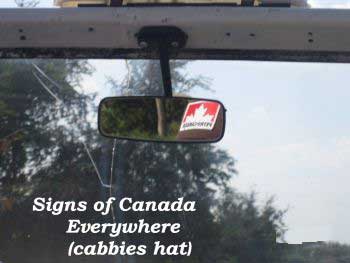 |
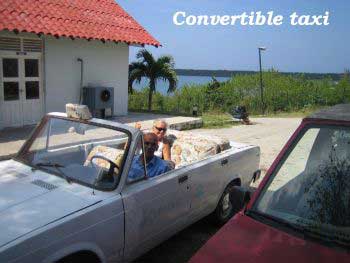 |
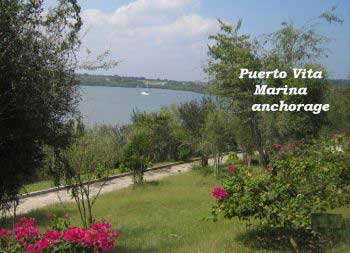 |
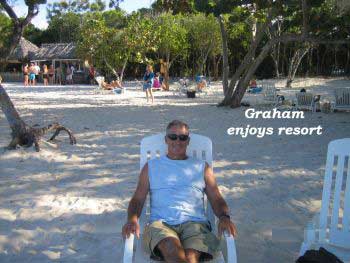 |
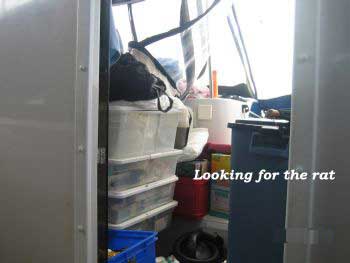 |
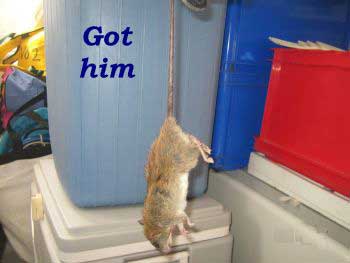 |
**What an inspection on arrival! First the doctor came on board and cleared us to take down the quarantine flag. (Commented on the cleanliness of the boat!). Then five people sat around the table checking documents (customs, immigration, agriculture, etc). Two others came with two dogs and sniffed around. The port captain and the marina boss came aboard later. Whew. This all took 2 hours. We have never been through such an inspection and apparently it was standard procedure. We were well prepared, with multiple copies of our crew list and travel plans, having read the guidebooks carefully. Everyone was supremely polite and all took off their shoes before entering the boat.
**Everything was culture shock to us and so fascinating. The most dramatic thing was to learn that people only earned about $15 per month though food, housing, education, healthcare, childcare, etc were all provided by the state. The young doctor did not have a car (very few people did) and much transportation was on the back of big trucks (where you had to stand up and hang on for dear life) or by horse-drawn vehicles. The doctor was so proud of the fact that there were email facilities at his clinic. During the inspection, some of the young officials were inspecting our CDs and DVDs very carefully and perhaps with envy. We must have seemed so rich to all of them. Almost embarrassing. Tina, a marina employee, who spoke quite good English (we had to learn basic Spanish quickly) advised us not to discuss politics or Castro with the officials. In fact, later we learned that Cubans all love to talk politics but they always look over their shoulders first! The country seems to be in a time warp and economically in dire straits (though everyone is cared for and there is little begging): people are waiting for a change and it is perhaps long overdue.
**For our first night in Cuba, we decided to stay tied up at the marina as we were so tired. Only one other boat (Norwegian) turned up while we were there and the marina was sadly deserted. Anyway, we were horrified to discover, after we were out at anchor that we had a RAT on board. Yes, a RAT. Graham first heard a funny noise, like birds walking on the deck, iin the night and then we saw the droppings in the morning. !@#$%^&. We confined the creature to the starboard cabin and put out some rat poison. Then we read the fine print and saw that it might take 4 days for the rat to die. No, no, no, not while it chomped away on all our belongings and even chewed some of the woodwork. Graham went into the cabin and methodically checked every container. Finally cornered that rat and grabbed it by the throat. Yes, he strangled it. He had gloves on. Yuch. We are going to be reluctant to tie up to a dock again. We'll get a rattrap and make some cones for the lines. When a Norwegian boat with 6 young guys turned up a few days later, we warned them about rats.
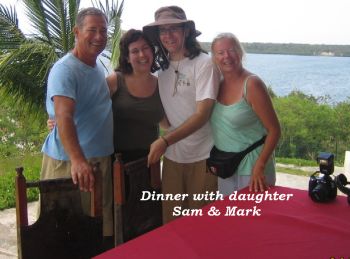
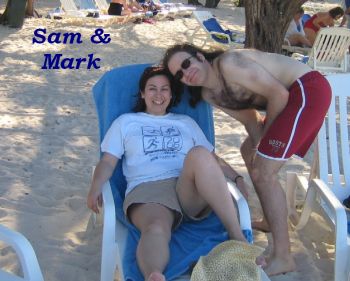 **With Sam and Mark, we took a bus tour to Gibara and Holguin, a museum full of rich Spanish colonial furniture, and a cigar factory. This was a great introduction to Cuba. The first apparent problem is that of transportation. The towns are as quiet as cathedrals where you can only hear the echo of human voices and various animals from the walls. No cars! No emissions pollution! Of course, the people would have cars if they could afford to do so. The buses are impossible and rarely travel to a schedule. It must be so difficult to get to work on time or to transport goods.
**With Sam and Mark, we took a bus tour to Gibara and Holguin, a museum full of rich Spanish colonial furniture, and a cigar factory. This was a great introduction to Cuba. The first apparent problem is that of transportation. The towns are as quiet as cathedrals where you can only hear the echo of human voices and various animals from the walls. No cars! No emissions pollution! Of course, the people would have cars if they could afford to do so. The buses are impossible and rarely travel to a schedule. It must be so difficult to get to work on time or to transport goods.
March 09 Bahia de Nipe (A). Lat 20 46.316N; Lo 075 34.451W
**We left Porta Vita on the same day that Sam and Mark left Cuba.
**We were up at 0600 so we could tie up to the dock and wait for the officials to give us the cruising permit and 'despacho'. (We had to provide the glue ourselves for them to stick stamps to our permit.) Four officials and a dog arrived at 0715 and conducted a search again. This was the pattern at every port in Cuba (no more dog searches, however) and it seemed a bit silly and quite annoying as you could not get an early start since as soon as they issued the 'despacho', you were required to leave within minutes. In most of the smaller ports, the 'guarda frontera' (coast guard) had to requisition a small fishing boat to row out to our boat. We never saw a dinghy or outboard motor used by the officials (not affordable, probably). We would have happily dinghied to shore but we were not allowed to leave the boat until searched. The searches were conducted by young officials (all male except for one female veterinary officer) who seemed so curious about our belongings and in awe of our boat. Though we were boarded about 15 times, there was never any suggestion of bribery.
Bahia was the first of many beautiful and totally protected bays on the north shore which we were grateful for as we were heading east to round Punta Maisi with the intention of exploring the south shore of Cuba. The guarda only spoke to us on the radio and did not board the boat but we were not permitted to put down the dinghy.
March 10 Bahia de Tanamo (A). Lat 20 42.227N; Lo 075 20.1W
Another beautiful protected bay. The scenery is stunning (sometimes seems like a northern shore in Canada) and appears to be mainly uninhabited.The sea state was calm and we had an easy time - motoring, of course. We called the guarda on the radio but there was no response and nobody turned up.
March 11-15 Bahia de Taco (A). Lat 20 31.339N; Lo 074 40.301W
Another incredible bay. When they do open up these bays to cruisers one day, sailors will flock here. However, today, the bays are totally isolated. Of course, there is nowhere to spend money either.
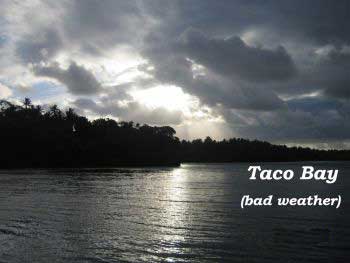 |
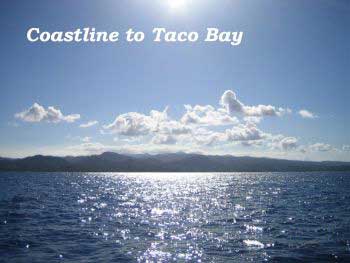 |
**In the night, some fishermen came by in the dark (we could hear their voices) and we went on deck and had a chat with them. They were fascinated with our solar-powered lights. They burned fuel (kerosene) in their lanterns and could not afford anything with batteries. Their engines (some had engines) were ancient in-board types. We gave them some fishing hooks and lines, and some t-shirts. There was nothing threatening about the people anywhere and they were always polite and friendly.
**Two fishermen in their dilapidated leaking boat rowed the young guarda toour boat the next morning and he seemed quite flummoxed about how to handle the paperwork. He was standing in a pool of water in the fishing boat and he did not come aboard our boat. He wrote down details on scraps of paper (no forms to complete) and we had to give him a pen. (I had prepared forms with all the details and most officials were gratefulfor this as it saved them time.) He told us we could not put down the dinghy. He came back an hour later as he had not inspected our passports! We tried to leave the bay on the second morning but it was too rough to get safely through the reefs on either side of the entrance and we were stuck here for five nights. None of the fishermen could go out either. It was quite frustrating, as we could not go ashore, but we kept ourselves busy (sewing, repairing, chart work, GB made bread, watched DVDs, etc). The weather was really bad (the fronts regularly extend to Cuba from North America) but we were well protected. On the third day, the wind shifted, with driving rain, and we dragged on the anchor. Anybody who regularly anchors without a GPS alarm is nuts. It provides such peace of mind and does not consume a lot of energy. It was not a big deal to reset the anchor. The guarda came over on the fourth day to make sure we were OK and to advise us to wait another day for the weather to improve. We were getting a bit itchy for some fresh food and we ate a lot of canned stuff in Cuba.
March 16-17 Baracoa (A). Lat 20 21.068N; Lo 074 30.142W
The front had passed through and the winds were back in their ENE 10-15 knot pattern. We had an easy trip to Baracoa where we were finally allowed ashore. Another cruiser (French flag) was anchored in the bay but was told to move on as Baracoa officials could not handle international arrivals. They were quite upset, having travelled several days from the Virgin Islands and we gave them all the details for clearing in at Puerto Vita.
**A gang of officials visited us again and they arrived in broken down rowboats. Few pleasure yachts visit Baracoa. Everyone was very polite and took off their shoes again (eventually we told people not to worry about this kind gesture!). Wendy had a great chat with the lady veterinary officer in our common language of French. (Many Cubans speak 2 or 3 languages. They are only just learning English routinely as Russian used to be the second language.) It was kisses and hugs for us. (Cubans are very touchy people and that suits me fine!) Ours was the first yacht she had ever inspected and she admitted to being terrified of the sea. The port 'capitaneria' had to hold her hand as she was so frightened. We had to wait for radio permission to go ashore and there was even debate as to whether we could offload our garbage (which had been collecting for a week!). They finally decided to take our garbage and we watched some fishermen rummaging through as they retrieved some plastic bottles. It was 3 hours before we could go ashore ourselves. This is all so fascinating!!
**On Saturday morning, we went to a huge outdoor market and were absolutely stunned at the low prices. We filled three bags (had to bring your own bags) full of fresh goodies and could barely spend $3. For example, a big head of cabbage cost the equivalent of $00.05 Canadian. We had to queue in long lines to get the food. Everyone walked around with his or her still-squawking chicken hanging upside down. (We passed on that one!) We were the only 'gringos' among hundreds and hundreds of people. The Cubans get ration cards for most of their food but markets have been allowed to operate for the past few years. All prices are fixed and there is no haggling. There are two currencies in Cuba: 'Cuban' pesos for the locals and convertible pesos for whoever can get them. Foreigners must use convertible pesos (at foreigner prices, too) but we found many places to use 'Cuban' pesos for some real bargains.
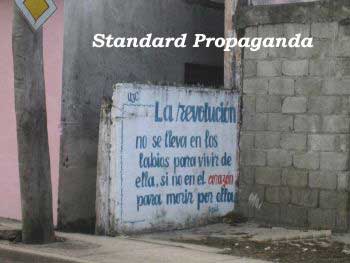 |
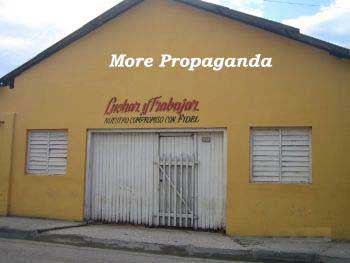 |
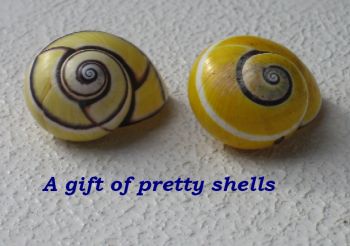 |
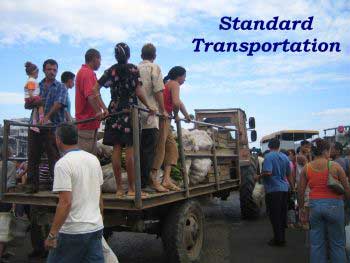 |
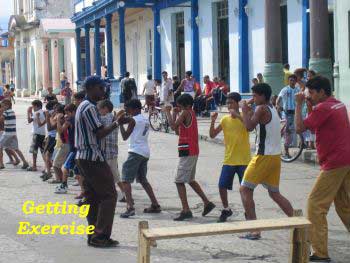 |
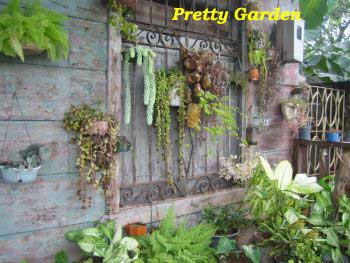 |
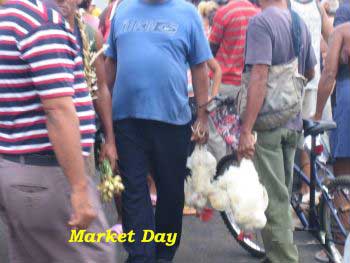 |
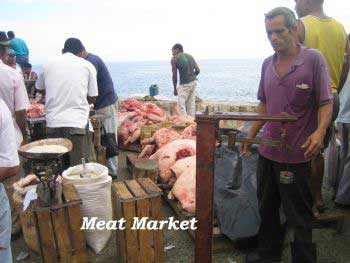 |
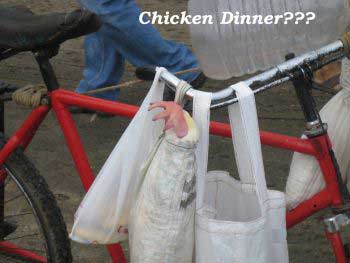 |
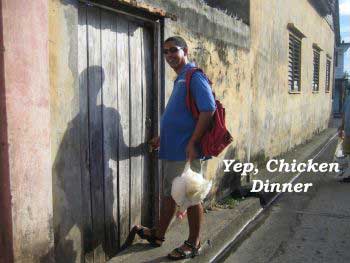 |
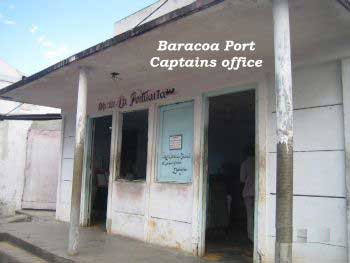 |
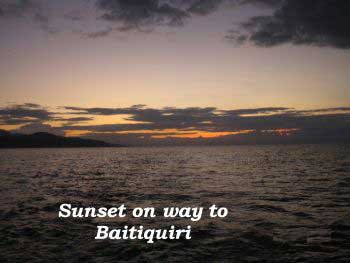 |
March 18-19 Baitiquiri (A). Lat 20 01.721N; Lo 074 51.625W
We planned an overnight to get around Punta Maisi (notorious for possible confused seas) so we had the Baracoa officials come over about 1500 to clear us out. The whole gang came over again in the rowboat. They were so sweet and seemed upset that we were leaving so soon. The lady vet (more hugs and kisses) wanted us to stay for a night on the town and some dancing but the wind was changing and there was quite a bouncy surge in the harbour. We wanted to leave. One of the officials 'snuck' me two beautiful little shells with a pleading look not to let the boss know. I 'snuck' them a plasticag of goodies (ostensibly garbage) too but this had to be done very carefully so there was no question of bribery.
Anyway, the trip was quite easy and the scenery was spectacular. Two Baitiquiri officials came over and were very polite but we were not allowed ashore. The bay was gorgeous and we would have loved to do a little exploring. No swimming either as the bay was full of jellyfish.
We planned to leave on the second day for an overnight to Santiago de Cuba. We had asked the guarda to clear us out at about 1600. We could not raise anyone on the radio and gave up on the radio in the smaller towns. We finally moved the boat closer to the guarda dock and just parked ourselves right there in front of them. They got the hint, found a fisherman to row them out, and we cleared in a few minutes. Geez, what a laborious system.
March 20-24 Santiago de Cuba (M). Lat 19 58.989N; Lo 075 52.380W
The trip to Santiago Cuba was great and we sailed most of the time. It was fascinating passing US-occupied Guantanamo Bay, where we were forced to stay five miles offshore, as it was lit up like a football stadium for miles along the shore. The cost of the electricity consumption at Guantanamo could have powered all the homes of Cubans who were very frugal with their energy use.
By 0730, on the second morning, we were docked at Santiago de Cuba but the official process was not over until 1300. Although the procedure was short for us as we had already cleared in, there were 6 other boats (one other Canadian from Quebec, one Swedish, one Norwegian, one German, one French and one Italian) newly arrived from other countries. We were in heaven: it was fantastic to finally meet and speak with other cruisers and I think we all felt the same way. We had a wonderful few days exploring amazing Santiago de Cuba with Italians, Claudia and Lino, and I had tears in my eyes when we said goodbye. Between us, we communicated in English, French, Italian and Spanish. I made a Q flag and fixed a leecloth for the young Norwegians.
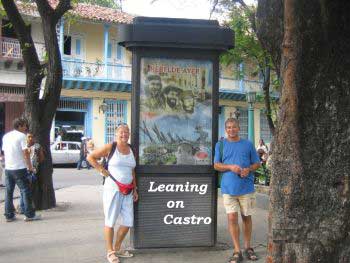 |
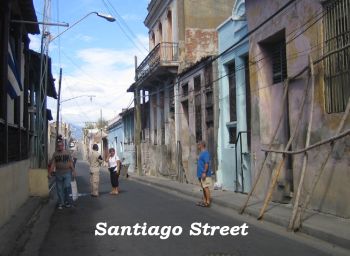 |
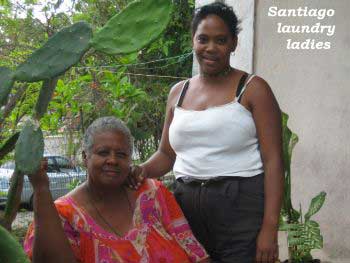 |
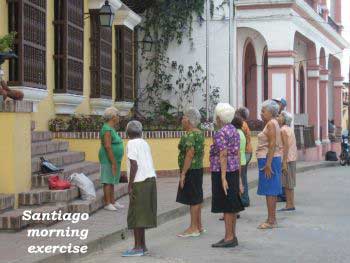 |
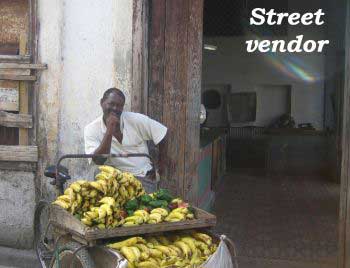 |
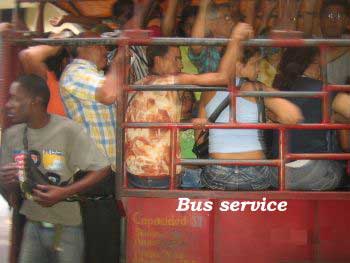 |
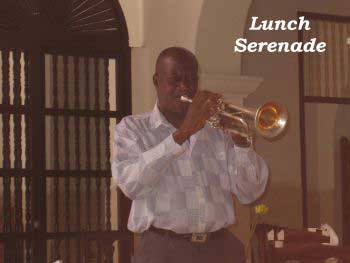 |
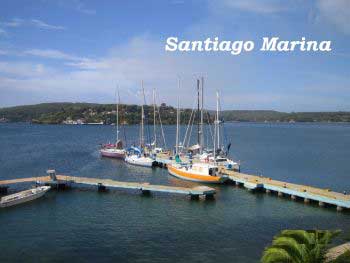 |
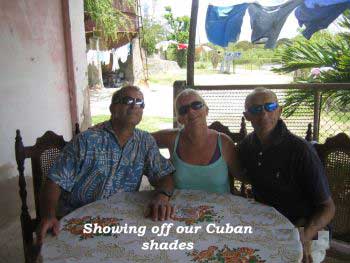 |
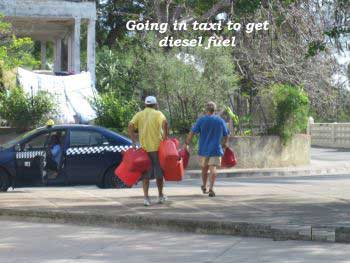 |
March 25 Chivirico (A). Lat 19 58.124N; Lo 076 24.144W We had the fastest clear out ever (4 minutes) as the port captain had lots of work for the day. Great sailing though wind died midday. Spectacular scenery. Kids and grownups waving to us from shore - they rarely see cruisers. Guarda turned up in the rain in another tired fishing rowboat. Copied down the same information. Quiet night. Not allowed ashore. March 26 Marea de Portillo (A). Lat 19 54.840N; Lo 077 11.109W Gorgeous shoreline along the 9-hour sail to Portillo. The days are so long now (sunset after 1900) that there is no panic if we anchor a little later than usual. Guarda was rowed over by a lady 'pescadora'; she came back later and brought us a big bag of fruits and veggies. Much appreciated and we traded some of our goodies too. Very good anchorage. March 27 Cabo Cruz (A). Lat 19 50.392N; Lo 077 43.830W Lovely sail. Spending so many days sailing and we are trying not to do overnights but it makes you ponder the huge size of Cuba. Guarda here was quite rude. Not allowed ashore and not allowed to Manzanillo or Niquero where we were hoping to buy fuel. W worried about this but Graham confident that we could go a long way downwind and he was right. To get fuel we had to go to Casilda or back to Santiago de Cuba (no, no, not east). We took the long route (several days) through the inner cays to Casilda. (No fuel there either, but we finally got some in Cienfuegos.) March 28 Cayo Sardina (A). Lat 20 25.343N; Lo 077 57.512W Before we left at 0730, the Guarda came aboard again and checked all cupboards (in case we were smuggling some Cubans out?). We gave a t-shirt to the poor guy who had to row out the Guarda and they looked a little miffed about it. One young Guarda asked Graham how much a pair of his shoes cost but that was the only overt hint at a gift that we ever encountered. All officials were quite proper. Wendy very, very down tonight as our anchorage was howling with wind and we worried about holding all night. The wind started within minutes at about 1900 and carried on all night - the regular pattern in this part of the world. **We had many anxious moments in Cuba and perhaps this was due to the isolation, long distances, lack of other cruisers and few opportunities to go ashore. For many weeks now, Wendy has been warning Graham that it is not
likely that she will go across the Pacific or the Atlantic and he seems to finally be accepting this. The loneliness of Cuba seems to be accentuating the distance from family and friends. Very much looking forward to our summer
visit to Canada. March 29 Cayo Grenada (A). Lat 20 37.636N; Lo 078 14.933W We were both tired after a fitful night of howling 25+ knots. However, the 6-knot sailing to the next beautiful but deserted cayo was great. At 1900, the wind piped up, almost to the minute, but we were less exposed this time. March 30 Cayo Algodon Grande (A). Lat 21 06.021N; Lo 078 44.047W Starboard windlass (the big one) acting strange. Bumpy sailing with one reef. March 31 - April 01 Cayo Cuervo (A). Lat 21 04.763N; Lo 078 57.469W 5+ knots on the genny alone! Only two more days and we will be in civilisation. Graham took apart the starboard windlass. The motor (still on warranty) is kaput. We switched to the smaller Bruce but that windlass does not work either though it is easier to haul. (Ha, we only used the Bruce in our first year and never dragged at all.) We stayed an extra day to get some chores done and to get a break from the sailing. **Well, we have had enough of Cuba. It's official. Too many long stretches with not a soul in sight. Both a bit down about the cruising lifestyle at this point. Never want to see another mangrove cay again. April 02 Cayo Zaza de Fuera (A). Lat 21 27.957N; Lo 079 34.455W We averaged 5.7 knots (anchor to anchor) only sailing with the main and the genny. Good sailing all week. Food supply low except for canned goodies. Some guys on a big fishing boat anchored near us and called us over. Gave us some beautiful red snappers. April 03-05 Casilda (A). Lat 21 45.152N; Lo 079 59.531W Oh joy, we are going to civilisation at last. Waited 45 minutes for officials at a nasty windy anchorage in front of the town dock and then they told us to go into the 'marina'. We struggled over very shallow waters across the bay and re-anchored, only to be hollered at and told to tie at the marina that was tricky in the wind. Oh well, feeling good to be among other people
(but no other cruisers) and organising sightseeing. **A rather tumultuous event followed in which we realised how tricky it was to handle emergencies from Cuba. We received an evening email from Andrew saying his lawyer unexpectedly advised Andrew that he would need cheques totalling $25,000 in two days or he would not be able to move into the condo. Right out of the blue. We were lucky that we were near a hotel with Internet as computers are rare in Cuba. (That ridiculous embargo must stop soon.) What a shock to the system. It took all day to sort out the problem. Our banker upped our overdraft but the system would not allow us to direct transfer this large an amount via Internet). So we transferred it to his Visa account but that was not the right thing to do either as it takes four days for the Visa money to go through. In the end, Andrew's banker set up an unsecured overdraft facility for us (all by email) and we direct transferred that amount to Andrew's account. This saved the day. It took many emails and some phone calls (at $2 per minute) to sort it all out. (Email is definitely the only way to go and we can send emails via ham radio every night for free.) Andrew paid off the overdraft four days later when the Visa money went through and we were not charged any interest.
Confused? Ha, we went through hell. April 06-12 Cienfuegos (M). Lat 22 07.487N; Lo 080 27.181W **From Cienfuegos, we took a bus to Havana ('Habana') and stayed overnight for a couple of days in a 'casa particular' (room in a private home), about $35 per night for the two of us, including a full breakfast. What a magnificent city and the sophistication in some areas is such a contrast to the rest of the country. The buildings are stunning and reflect the very rich colonial era when the Spanish ruled. Many buildings are sadly decaying though there is much effort to keep up the tourist areas.
**Shrieks Wendy). Discovered a cockroach in the cockpit. Put out the roach trap but nothing caught. Perhaps it came in on some food. It was bound to happen even though I soak all food in a bleach solution and unpack all cardboard before anything goes in the galley. **We had the two windlass motors fixed here for about $15 each. Done in the same day. Cubans can really fix anything. In North America, we would have been advised to buy new motors, at plus $400 each. April 13 Cayo Dios (A). Lat 21 37.981N; Lo 081 10.730W We ended up anchoring 10 hours to beautiful Cayo Dios as there was so little wind. 'Kestrel' (oh joy, another boat) was anchored there too and they had spent the day snorkelling in the calm weather. Swimming was a quick dip for us as two big barracudas hovered off the stern, their nasty teeth clearly visible in the crystalline waters. Such curious animals, and reputedly harmless unless provoked, but we're not taking chances. April 14-16 Cayo Largo (A). Lat 21 37.352N; Lo 081 33.855W We woke up to strong winds and lots of rolling so decided to forego the snorkelling plans and carry on to Cayo Largo. Great sailing: 6-7 knots. A beautiful anchorage at Cayo Largo. However, anchorage was grassy, and when the wind clocked around to NW, we dragged at 0130, 0445 and 0500. Wow, three times in one night. Not fun trying to reset anchor in the dark and
clearly able to see (moonlight) the sandy shallows a few feet away. Luckily, Graham had fixed the heavy starboard windlass that morning so we were able to switch to heavier tackle. We re-anchored again at daylight taking no chances - 120 feet of chain in 8 ft of water. April 17 Canal del Rosario (A). Lat 21 37.315N; Lo 081 55.986W **One of the best things about Cuba has been the perfect sailing conditions. We have probably sailed about 75% of time. Good thing too, as it was not easy to get fuel. Apri 18 Cayo El Navio (A). Lat 21 52.853N; Lo 082 35.990W We woke up to the calmest morning we have experienced in Cuba and had to motor for 8 hours to the next deserted anchorage. ** OK, we have had enough of quiet beautiful deserted anchorages in the middle of nowhere. Both recognizing that we are 'lonesome' and wanting to meet up with other cruisers. Not many of us here in Cuba. April 19 Ensenada de los Barcos (A). Lat 21 56.031N; Lo 082 58.943W Air in the port engine and spent some time bleeding engine. It was slow and uncomfortable going with 15 knots on the wind. Averaged 3.8 miles per hour. April20-21 Siguanea (M). Lat 21 37.075N; Lo 082 58.814W Graham removed the Racor filter and the air problem vanished. Bloody filters - same thing happened on starboard side. He repaired it later that evening and replaced it as we did not want to leave the system without the filter. Engine worked fine. What a lousy marina. Sixty cents per foot (most expensive yet) with an electrical hook-up that consisted of bare wires and no ground (no way we were going to touch that stuff) and a water pipe with no attachments and rusty water. There were no options for anchoring so we had no choice but to tie up at 'marina'. On the morning we left, we had to wait one hour to check out and pay officials. We enjoyed dinner at the nearby diving hotel and took a bus to Nueveo Gerono for some shopping and to get some money for our last few days in Cuba. April 22 Cayo Cocos (A). Lat 21 57.028N; Lo 083 27.757W Great sailing, 7 knots with the main and genny. The entrance was tricky and shallow but the anchorage was calm and beautiful and isolated. Starting to get a little anxious about the Yucatan Channel, which we will be facing in a few days. The wind howled up in the night. April 23-24 Cortez (A). Lat 22 02.449N; Lo 083 58.010W **Major disasters today and our nerves were quite fraught when we arrived at Cortez just before sunset. However, we handled it all and ended up being proud of ourselves. Cuba is definitely not for inexperienced sailors as there is no one to help you in hundreds of miles. **First, the wind was 20+ knots and we bumped the bottom on our way out of the tricky anchorage. At the same time, the port engine 'blew'. We had what is called 'runaway' engine, which we managed to stop by cutting off fuel but blue smoke burped and blasted, adding to the tension. We had no port engine from then on. **Second, in all that excitement, we somehow lost track of our route and ended up hard aground on the only shoals marked on the chart. !@#$%^& Now this was scary as there is nobody around to help. With the winds howling, we set out anchors from both bows and after 3 hours of kedging, we managed to float off. (The port windlass motor died again, after all this effort.) It was extremely nerve-wracking. On top of all this, we needed to get moving to be able to enter the next hairy anchorage in daylight. In spite of it all, we knew that if we were stuck here, we had enough supplies to survive and our lives were not in danger. Imagine the relief, when we got off the shoals. **Third, the entrance into Cortez was the scariest we have ever encountered on 'Bravo 2'. The wind was strong, the waves were pounding, and the markers were not clear. (Don't forget that the guidebooks are about 10 years old.) Some fishermen waved us to go further offshore and in doing so we went on the wrong side of the markers! (We discovered this the next day when we went out in the dinghy to do a little recce and probe for the bottom with the boat hook.) Somehow or other, we made it in, with the depth sounder sometimes reading less than 3 feet. Whew, we were grateful for our shallow draft but I would advise anyone with a normal draft never to go near the place. **Finally, we anchored in the beautifully calm bay. An hour or two later, in the dark, a big fishing boat sauntered up with one little light and with a guarda on the bow, yelling across at us. He informed us that we had to leave the next morning. No way. We said we had engine problems and the wind would be on our nose and he said (in Spanish remember, so maybe we got it wrong) we got in so we could get out. Ha. We objected. He got on the radio to his boss who said we had to anchor across the bay (5 miles) immediately, in the dark, so they could keep an eye on us. Well, that did it. Graham was totally fed up with the ridiculous officialdom and just put his foot down and said no. 'No, esta noche'. The young guarda did not know what to do, got on the radio and finally yelled over 'Buenos noches'. The next morning, we motored over to the dock and said we were staying another night and they did not object at all! They did not even come over to check the boat. **What a hell of a day! We were keen to leave Cuba. April 25 Maria la Gorda (A). Lat 21 49 .131N; Lo 084 29.915W **Our last stop in Cuba! To be frankly honest, we are glad and hoping to see more 'life' in Mexico. Can't wait to go shopping (mainly for food) and to get on the Internet. As you will see in the next log, life turned around completely with lots of great cruisers at Isla Mujeres and many places to see and visit. We might feel more kindly towards Cuba with time, but it has definitely been our least enjoyable cruising experience. Be sure to read the other instalments of Wendy and Graham's journal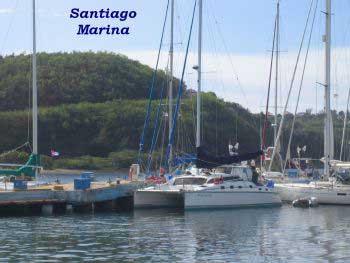 **Cruising in Cuba is not easy, and definitely not for most of the Bahamas and Eastern Caribbean crowd. (And, of course, not for Americans, for political reasons.) For one thing, Cuba is BIG and it takes time to get from one end to the other. The weather patterns are different and caution is required at the many reef entrances. The Cuban charts, buoy systems and lights, are excellent but there is no one to help you if you get in trouble. Further, it is very difficult to provision and so you need to be self-sufficient and well stocked It's not just a problem with basics such as food. For example, we could not get diesel for more than 650 miles and we were so relieved that we could sail 75% of the time as we were heading west with the winds behind us or on the stern quarter. The officialdom can be overwhelming but in fact, becomes quite routine after awhile. Cruising here takes effort and skill and confidence.
**Cruising in Cuba is not easy, and definitely not for most of the Bahamas and Eastern Caribbean crowd. (And, of course, not for Americans, for political reasons.) For one thing, Cuba is BIG and it takes time to get from one end to the other. The weather patterns are different and caution is required at the many reef entrances. The Cuban charts, buoy systems and lights, are excellent but there is no one to help you if you get in trouble. Further, it is very difficult to provision and so you need to be self-sufficient and well stocked It's not just a problem with basics such as food. For example, we could not get diesel for more than 650 miles and we were so relieved that we could sail 75% of the time as we were heading west with the winds behind us or on the stern quarter. The officialdom can be overwhelming but in fact, becomes quite routine after awhile. Cruising here takes effort and skill and confidence.
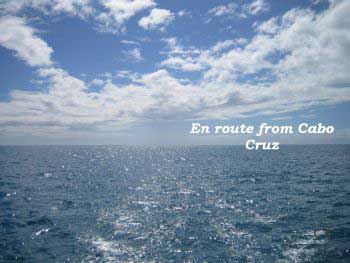
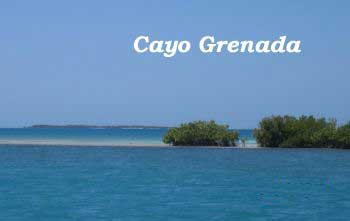
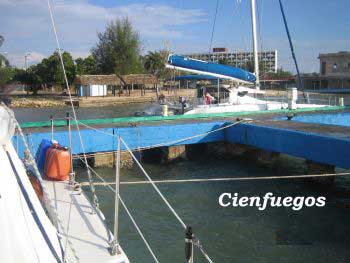
![]()
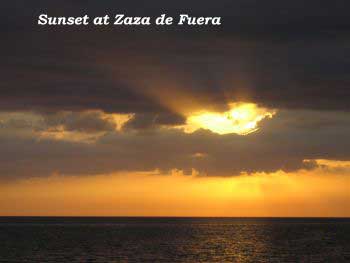
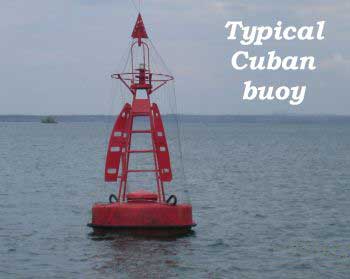
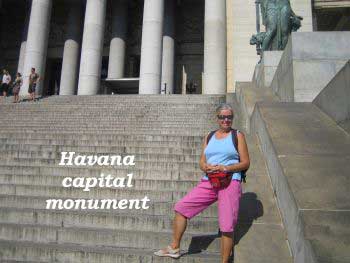
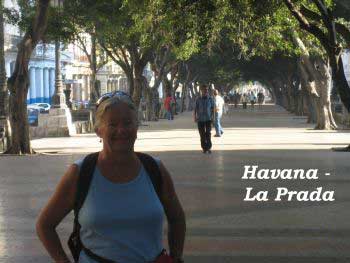
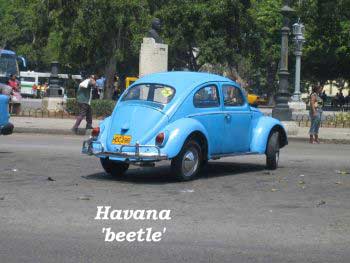
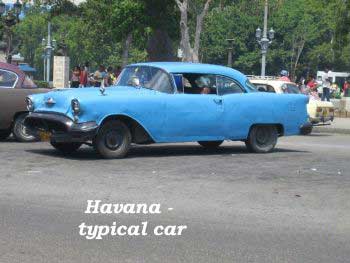
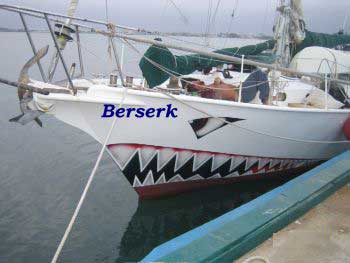
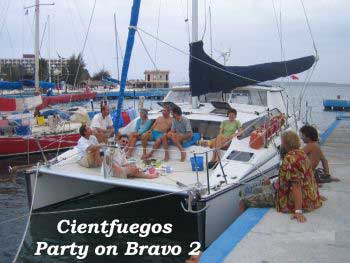
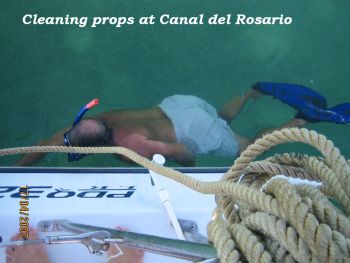
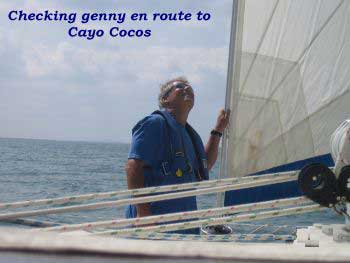
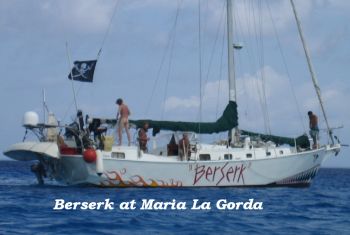
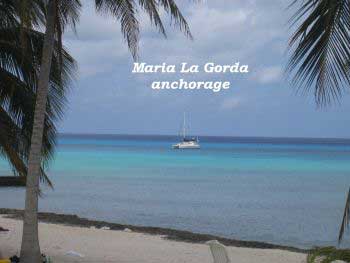
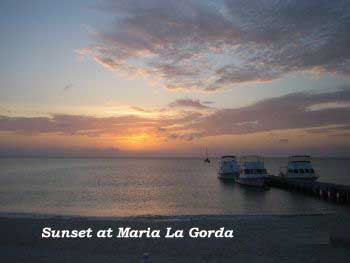
The Adventure Continues.... 2007:
Part 3